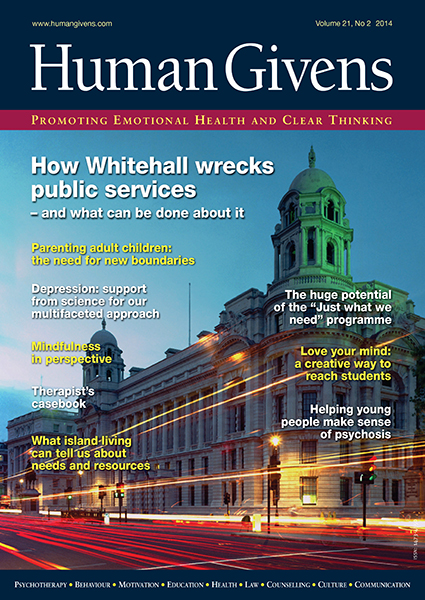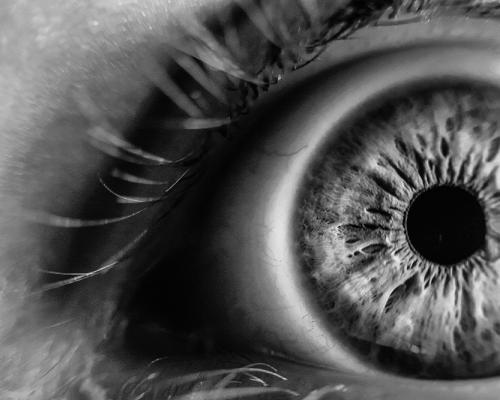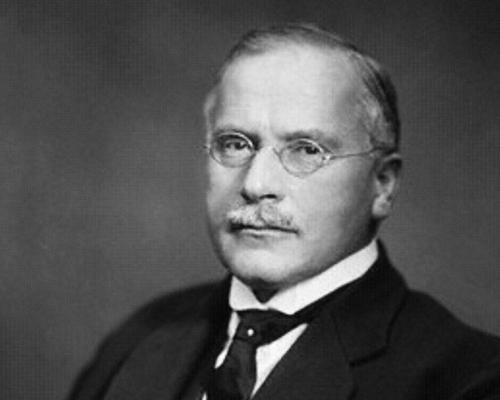The brain inflamed
GP Andrew Morrice explores the part inflammation plays in depression and how that connects with human givens understandings.
All human givens practitioners work from the understanding that depression is not primarily a biological illness.1 We realise that the idea that depression is a ‘biochemical imbalance’ or a ‘genetic’ problem is misleading, disempowering and (ultimately) nonsensical. We know that the most effective way to approach treatment is to help people get their innate needs healthily met and use their innate resources effectively. Yet in many traditional cultures what we call depression is experienced as a physical illness. We also know that depression is intimately linked with multiple chronic diseases. Evidence emerging over the last decade or two shows that depression is probably more like a physical illness than any other mental health disorder. How does this affect the human givens model of depression?
This article has come about as a result of preparation I carried out for the one-day course I now deliver for Human Givens College on the mind-body connection. The reading and reflecting this entailed opened up some extremely interesting new perspectives on depression, with information drawn from a variety of sources: studies of immune function, the science of inflammation; and observations of how animals behave when sick. The exciting implication of this scientific information is that a richer understanding of innate physical needs and physiological resources helps us understand depression in even more depth and meshes with our human givens model of depression. This, in turn, may enable us to help people with depression even better than before.
Inflammation is the key to the new understandings. The ability of our bodies to become inflamed, and our immune system’s capacity to heal wounds are amongst the most fundamental and ancient innate resources we have. Because inflammation is generally accompanied by heat, swelling and pain, we instinctively tend to see it as ‘a bad thing’. We all resent the symptoms and often put a good deal of effort into opposing them with anti-inflammatories and painkillers. Yet no wound can heal and no infection can be combated without inflammation. It is chronic inflammation that causes the problems, and the modern epidemic of diseases in which it plays a part can be seen as an example of a resource that is running out of control. For chronic inflammation just goes on and on, pointlessly and counterproductively, like a TV left switched on in the corner of what could be a lovely room in which to sit and talk.
It has been recognised for at least 15 years that immune system activation (which involves inflammation) and the condition we call depression share many psychological and physiological characteristics. These include depressed mood, loss of interest or pleasure in activities, appetite disturbance, changes in body weight, sleep disturbance, psychomotor disturbance, fatigue, loss of energy, and difficulty in thinking or concentrating. 2,3 This is borne out by research on cytokines (a family of compounds involved in inflammation and immunity). Animals given cytokines become lethargic and withdrawn, lose interest in eating, sex or being with others, and are more sensitive to pain. When patients receive a cytokine-based medication for chronic hepatitis C, very many become depressed.4 People with depression commonly also suffer from physical aches and pains that don’t seem to be connected with any physical activity or illness but which are of the kind that can occur in inflammatory illnesses – such as arthritis, inflammatory bowel disease and fibromyalgia. At least two studies have shown that raised inflammation (as measured in a blood test for the inflammatory biochemical creactive protein), is associated with an increased incidence of depression.5 One study, of 70,000 Danes, found that elevated levels of the protein were associated with a two- to threefold increased risk of depression in the general population.6
Many of the chronic diseases that cost us so much in terms of lost quality of life, and healthcare funding have links to depression. These include heart disease, stroke, arthritis, dementia and diabetes. It used to be thought that patients with these conditions were depressed because they had a chronic disease. But it is now recognised that the depression seen in these conditions may arise from the same biological roots as the chronic conditions themselves. Some researchers have suggested that inflammatory illnesses and infections should be regarded as risk factors for depression.7 Others have gone further and suggested that malaise (the generalised feeling of being unwell) is the core symptom of depression, and that many antidepressants work by reversing this feeling of malaise.8
All this may, at first sight, seem to contradict the human givens model of depression, which holds that the core of the difficulty in depression is a disturbance in the REM cycle caused by excessive emotional arousal, itself almost always caused by rumination. But it doesn’t. One of the organising ideas that lies at the heart of the human givens approach is that helping people to understand what is right with them is key to helping with what is going wrong. This insight is linked to understanding problems not just in terms of innate needs not being met, but also in terms of innate resources being misdirected or working out of balance. A person suffering with panic attacks can relate to the situation differently when they understand that a life-preserving system is being activated inappropriately, if for often understandable reasons. This is why many human givens practitioners, instead of simply seeing the processes that create symptoms or experiences as problems, may instead ask the basic question, “What is this for?” It is so much easier to deal with anxiety when we understand what anxiety, as a given human capacity or resource, actually enables us to do. So, we can ask ourselves, what is depression for? And perhaps, as so often, looking at the animal world can help us.
Sickness behaviour
Let’s imagine a social animal, like a wolf or deer, that is injured or has caught some kind of infection. We know that this animal will often take itself away from its social group, perhaps seeking a sheltered corner or a cave or simply a hole, where it can curl up, fall asleep and then either recover or die. We may have witnessed a pet doing the same thing. The behaviour makes sense. The herd or pack is spared contact with the sick group member, and the sick animal is able to maintain a state, undisturbed, in which it will either get better, or not. Biologists call this sickness behaviour – an instinctive response to a situation, with obvious usefulness and benefits. What is interesting is that this pattern shares many of the hallmarks of depression: reduced activity, increased sleep, disturbed appetite, withdrawal from social relationships and situations. Indeed, a feeling of ‘wanting to crawl into a corner and die’ is highly resonant for people who are depressed, and probably not simply as a metaphor.
Key to understanding this overlap between depression and sickness behaviour is inflammation. This connection is so clear that inflammation is actually used in experimental animals to produce depression in order for research on depression to be carried out. The scientific literature is clear that sickness behaviour and depression are linked, and that inflammation and depression are linked.9,10 If the human givens model of depression fits with this scientific evidence, then we would hope to find research that demonstrates that inflammation and emotional arousal are linked. And, indeed, they are. We know that, through a whole series of mechanisms, emotional arousal over long periods of time (termed “chronic stress” in the scientific literature) profoundly alters the way the body functions, and one of the key changes is an overall raised level of inflammation.11,12 Second, we would hope to find that excessive REM sleep is linked to inflammation, preferably as a cause. And, again, indeed, it is. Research shows that disturbed sleep, particularly difficulty getting off to sleep, causes the inflammatory changes implicated in illness and depression.13 Excessive REM sleep is also causally linked to the same changes.14
Human givens practitioners are likely to be familiar with the concept of depression switching on and off, and many may be aware that there is a specific centre in the brain known as Brodman area 25 (BA25) in the brain’s anterior cingulate gyrus, which, in recent years, has been discovered to be highly activated in depression.15 It is a good working hypothesis that it is activity in this area which is responsible for the appalling gloom experienced by many people who are depressed. If inflammation causes depression, we would hope to find that this has been linked to BA25. And, indeed, research has shown that the changes in this area seen in depression can also be induced by inflammatory changes in the brain.16,17,18,19
All this makes it possible to create a hypothesis linking depression, emotional health, sleep, dreaming and inflammation. Our brains, like those of our animal ancestors, have evolved to respond to the chemical changes needed for inflammation by triggering off changes in behaviour that look very much like depression. The physiological changes that happen in the body (including the brain) during ‘chronic stress’ also involve inflammation. From the human givens perspective we describe this as arising from failure to have our emotional needs met, and crucially the misuse of our resources of imagination. As the limbic and other autonomic centres are unable to distinguish reality from ‘simulated’ reality, it is clear that rumination and the failure to get needs met can directly increase levels of inflammation, create changes in behaviour and (human givens practitioners would add) patterns of thought, and switch on BA25. We know that once this last step happens, the switching on of BA25, a person will experience intense feelings of depression. It is even highly possible that it is the activating of this switch that ultimately distinguishes true depression from fatigue, malaise, and low mood.
REM–emotional arousal connection
It may well be that one of the key ways in which this process of inflammation arises in the brains of human beings is through the REM–emotional arousal system, in addition to its effects on attention and energy. Emotional arousal itself creates inflammation, but the consequent loss of deep recuperative sleep through the resultant REM sleep excess creates further inflammation. As we know, the resulting changes in energy, mood and the tendency to continue to ruminate keep the whole set of processes running in a vicious cycle, until something occurs to break it.
There are a number of ways in which these insights may help us. First, the ‘sick animal’ metaphor resonates with depressed people. I find it passes what I call the “nodding patient test”. Eleven years ago, when I first learned the human givens model of depression, what impressed me most was that patients just nodded a lot when I shared the ideas with them – they recognised the information as much as they were learning it. Providing explanations that pass the “nodding patient test” helps build rapport as well as enabling the patient to view their situation more objectively, yet also partly from within their own knowledge.
Secondly, this extended model of depression describes the problem as an innate resource that is being inappropriately triggered. Ultimately, the value of behavioural therapy derives from the insight that the behaviour patterns of depressed people are in and of themselves a recipe for depression. Now we can clearly explain why, in order to recover, the patient must do pretty much the opposite of what the depression is instructing them to do.
Pattern matching
The human givens understandings of pattern matching can be helpful here. I can tell patients with depression that the brain can get sore, just like a throat, and that this can set off an ancient pattern match to sickness behaviour (the withdrawal response). If they have been battling an illness such as flu, the response is appropriate. Learning that depression can arise in response to a physical illness is both comforting and enabling to many patients flummoxed by what has happened to them. Indeed, telling a patient this can also be extremely helpful in cases where the patient is either unable or unwilling to recognise a situation, event or rumination that triggered the depression, as they are more likely to accept it. What is important is that our techniques for managing depression are still appropriate, but we have an option for explaining them in a way that resonates more for these patients.
If – as is far more often the case – people have succumbed to depression through the other routes we have been discussing (their unmet needs and the stress and rumination this unleashes), then withdrawal is not appropriate and becomes part of the problem. In those circumstances, it is important to do the opposite of what the depression is telling them, and keep moving. I lay this on the line quite firmly, as I have only 10 minutes in my surgery in which to make an impact. I may say, “It is as if the depression is giving you instructions on how to feed it. I know that you don’t feel like it, but if you get back to the activities you do when you feel well, it will break the vicious cycle.”
There is now evidence that the changes we induce and recommend that our patients make to lift their depression also map onto a strategy of reducing inflammation. Aside from directly breaking the cycle of rumination, our approach to depression may commonly include 7:11 breathing and exercise. It will come as no surprise, now, that 7:11 breathing, along with other methods of inducing relaxation and reactivating more relaxed patterns of response in guided imagery (all routine components of a human givens practitioner’s toolbox) have an anti-inflammatory effect.20 Exercise is also an important way that we can reduce inflammation21 and modify the stress (i.e. emotional) response that is driving the cycles of inflammation and unhelpful thinking.22 We can also now see why improving diet quality is so helpful in tackling the tendency to depression. A diet high in unprocessed plant foods, with moderate seafoods and low in sugar, refined carbohydrates and animal products is highly protective against depression.23 The Mediterranean diet, for instance, which is quite strongly anti-inflammatory, has been shown to be associated with a 30 per cent lower risk of depression, whereas the classic modern Western diet promotes it. A healthy diet boosts the body’s capacity to switch off or damp down inflammatory responses, once they are no longer needed. (On its own, though, diet change is likely to take some time to kick in, so is probably best seen as part of a longer-term strategy.)
Anti-inflammatories
Perhaps this growing knowledge connecting depression with inflammation forewarns us of the direction that research into new antidepressant medications is likely to take. The cytokines are thought to reduce serotonin in the brain, and most antidepressants are thought to have anti-inflammatory actions.24 The current state of research is, however, unclear on whether existing anti-inflammatories are going to be helpful. The kind of medicines most people are familiar with are the drugs like ibuprofen, naproxen, diclofenac and aspirin, which are known as NSAIDS (non-steroidal anti-inflammatory drugs). Whilst one study published very recently appears to show that ordinary NSAIDS may help lift depression,25 other studies have shown they can block the effects of the antidepressants known as SSRIs.26 It is also worth saying that the risks of taking NSAIDS are well known and significant, and even purchased over the counter they are not, and should not, be recommended for low mood.
Another type of anti-inflammatories are much more specialist immune system medicines, such as infliximab (usually used for rheumatoid arthritis or Crohn’s disease), which has been studied for its effects in patients with resistant depression. Whilst it was shown, in one study, that patients with the highest levels of inflammation experienced a significant anti-depressant effect, those with lower levels did not.27 These are highly specialist drugs unlikely to be widely recommended for depression in the near future. However it is clear that the search is on for drug treatments targeting inflammation for depression.
From a human givens perspective, turning to more medication rather than addressing the underlying unmet physical and emotional needs of the patient may be a more complex and risky (even if, for pharmaceutical companies, a more profitable) route to follow. We have excessive inflammation for two main reasons: first, the drivers persist – examples may include ongoing rumination or anger, or excessive sugar or omega-6 fatty acids in the diet; second, not enough anti-inflammatory resources are available to let the body switch off the processes started by the inflammatory system. Reasons for this may include inability to relax, lack of exercise or lack of nutrients like omega-3 fatty acids, anti-oxidants and vitamin D.28
This brings us to an important principle. Things are not simple, or one-dimensional, when it comes to health. It is clear to me, from speaking to my patients, that many people with fatigue ruminate excessively and wake exhausted: yet they are not depressed. Other factors in their lives – diet, quality of relationships, meaningful work, exercise – are keeping them from developing depression. It is not unusual for me to speak to a patient in his or her mid-20s, who is inexplicably anxious or depressed, and the only change in their lives that we can find is that their previous sports activities have been sidelined by a burgeoning career or new relationship.
Postnatal depression
This intermingling of physical and mental components also fits with our understanding of depression that occurs alongside chronic illnesses, and postnatal depression. Research from nearly 15 years ago showed that mothers with the postpartum blues had higher levels of inflammation than mothers who did not.29 In a more recent paper outlining a new paradigm for depression in new mothers, the authors put it well: “Recent studies constitute an important shift in the depression paradigm: inflammation is not simply a risk factor; it is the risk factor that underlies all the others. Moreover, inflammation explains why psychosocial, behavioural and physical risk factors increase the risk of depression. This is true for depression in general and for postpartum depression in particular. Puerperal women are especially vulnerable to these effects because their levels of pro-inflammatory cytokines significantly increase during the last trimester of pregnancy – a time when they are also at high risk for depression. Moreover, common experiences of new motherhood, such as sleep disturbance, post-partum pain, and past or current psychological trauma, act as stressors that cause pro-inflammatory cytokine levels to rise.”30 Human givens practitioners would, of course, add unmet needs such as for security, connection, attention, control and being stretched, which are likely not to be well met when new mothers are inexperienced, isolated, overwhelmed by their baby’s needs and unprepared for such a huge, sometimes seemingly restricting, life change.
As ever, the picture we can build up from the scientific evidence is incomplete and many points remain to be answered. From a practical point of view, for example, we can see very fast changes when hope enters a depressed person’s consciousness. If hope is the “off” switch for BA25, how does this fit with the inflammation story? We don’t yet appear to know, but that needn’t matter for now. We can see there may be interesting links between sickness behaviour in other illnesses, how people around the ill person respond, and how this is reflected in physiology and healing – but that is another whole fascinating topic, well beyond the scope of this article.
A ‘whole person process’
To sum all this up, what is clearly emerging is that inflammation in the body, both systemically and specifically affecting the brain, is a mechanism that underlies and completely fits with our human givens explanation of how depression arises, and meshes neatly with many of the techniques we already use to tackle it. This makes the human givens approach congruent with the cutting edge of bio-medical research into depression. Because the human givens approach is based on sound principles, new information fits with it much more easily than with other models, specifically because the relationship between emotion (and the autonomic system) and what we like to call ‘thinking’ is accurately described. Understanding the role of inflammation enables us perhaps to share powerful new metaphors and strategies, and to stress the full value of many of the wide range of helpful changes that patients can make, particularly where these don’t appear at first sight to be linked to the original triggers of their depression. The inflammation theory of depression does not mean that depression is a biological illness, but it does allow us accurately to describe it as a ‘whole person’ process, and a genuinely biopsychosocial phenomenon. Lastly, as inflammation clearly arises when physical needs for appropriate activity and nutrition, as well as emotional needs, are inadequately fulfilled, the human givens framework of unmet essential needs resulting in mental and physical ill health remains fundamental.
In the end, I believe, health is all about relationships – how we relate to everybody and everything around us. We relate to our physical environment by moving around in it (in modern terms, taking exercise); we also relate to it in a very primary way through what we eat and drink. And we relate to others through our social connections. It is the richness and balance of all these relationships, and how we maintain them, that ultimately determine our health.
Andrew Morrice is a GP in Somerset. He has been using human givens principles in his day-to-day medical work for over a decade and holds the Human Givens Diploma. He runs the 1-day Mind–body Connection course for Human Givens College.
This article first appeared in "Human Givens Journal" Volume 21 - No. 2: 2014
 Spread the word – each issue of the Journal is jam-packed with thought-provoking articles, interviews, case histories, news, research findings, book reviews and more. The journal takes no advertising at all, in order to maintain its editorial independence.
Spread the word – each issue of the Journal is jam-packed with thought-provoking articles, interviews, case histories, news, research findings, book reviews and more. The journal takes no advertising at all, in order to maintain its editorial independence.
To survive, however, it needs new readers and subscribers – if you find the articles, case histories and interviews on this website helpful, and would like to support the human givens approach – please take out a subscription or buy a back issue today.
REFERENCES
- Griffin, J and Tyrrell, I (2003). Human Givens: a new approach to emotional health and clear thinking. HG Publishing, East Sussex.
- Dantzer, R, Aubert A, Bluthe, R M, et al (1999). Mechanisms of the behavioural effects of cytokines. In R Dantzer, E E Wollman and R Yirmiya (eds) Cytokines, Stress and Depression. Academic/Plenum Publishers, NY.
- Yirmiya R (1997). Behavioral and psychological effects of immune activation: implications for “depression due to a general medical condition”. Current Opinion in Psychiatry, 10, 470–76.
- Bonaccorso S et al (2001) Immunotherapy with interferon- alpha in patients affected by chronic hepatitis C induces an intercorrelated stimulation of the cytokine network and an increase in depressive and anxiety symptoms. Psychiatry Research, 105, 45–55.
- Marion Danner et al (2003). Association between depression and elevated c-reactive protein. Psychosomatic medicine, 65, 347–56.
- Wium-Andersen, M K et al (2013). Elevated c-reactive protein levels, psychological distress, and depression in 73,131 individuals. JAMA Psychiatry, 70, 176–84.
- Dantzer, R et al (2008). From inflammation to sickness and depression: when the immune system subjugates the brain. Nature Reviews Neuroscience, 9, 46–56.
- Charlton, B G (2000) The malaise theory of depression: major depressive disorder is sickness behavior and antidepressants are analgesic. Medical Hypotheses, 54, 126–30.
- Dantzer, R (2008). Op cit.
- Khandaker G M et al (2014). Association of serum interleukin 6 and c-reactive protein in childhood with depression and psychosis in young adult life. JAMA Psychiatry, 71, 1121–8.
- Maes, M (2009). Inflammatory and oxidative and nitrosative stress pathways underpinning chronic fatigue, somatization and psychosomatic symptoms. Current Opinion in Psychiatry, 22, 75–83.
- Sheldon, S, Janicki-Deverts, D et al (2012). Chronic stress, glucocorticoid receptor resistance, inflammation, and disease risk. PNAS, 109, 5995–9.
- Mills, J P et al (2007). Inflammation and sleep in healthy individuals. Sleep, 30, 729–35.
- Motivala, S J et al (2005). Inflammatory markers and sleep disturbance in major depression. Psychosomatic Medicine, 67, 187–94.
- See The gateway to (and from) depression (2007). Human Givens, 14, 1, 2–3.
- Drevets, W C, Savitz, J and Trimble, M (2008). The subgenual anterior cingulate cortex in mood disorders. CNS Spectrums, 13, 663–81.
- Haroon, E et al (2013). Inflammation induced changes in anterior cingulate cortex glutamate is associated with depression and fatigue. Brain, Behavior, and Immunity, 32, e33.
- Miller, A H et al (2013). Cytokine targets in the brain: impact on neurotransmitters and neurocircuits. Depression and Anxiety, 30, 297–306.
- Steiner, J et al (2011). Severe depression is associated with increased microglial quinolinic acid in subregions of the anterior cingulate gyrus: evidence for an immune-modulated glutamatergic neurotransmission? Journal of Neuroinflammation, 8, 94.
- Thayer, J F (2009). Vagal tone and the inflammatory reflex. Cleveland Clinic Journal of Medicine, 76, S23–S26.
- Hamer, M (2007) The relative influences of fitness and fatness on inflammatory factors. Preventive Medicine, 44, 3–11.
- Hamer, M et al (2009). Leisure time physical activity, risk of depressive symptoms, and inflammatory mediators: the English longitudinal study of ageing. Psychoneuroendocrinology, 34, 1050–5.
- Sánchez-Villegas, A et al (2009). Association of the Mediterranean dietary pattern with the incidence of depression. Archives of General Psychiatry, 66, 10, 1090–8.
- Maes, M (2008). The cytokine hypothesis of depression: inflammation, oxidative & nitrosative stress (io&ns) and leaky gut as new targets for adjunctive treatments in depression. Neuroendocrinology Letters, 29, 287–91.
- Kohler, O et al (2014). Effect of antiinflammatory treatment on depression, depressive symptoms, and adverse effects, JAMA Psychiatry, doi: 10.1001/jamapsychiatry .2014.1611
- Warner-Schmidt, J L et al (2011). Antidepressant effects of selective serotonin reuptake inhibitors (SSRIs) are attenuated by anti-inflammatory drugs in mice and humans. PNAS, 108, 22, 9262–67.
- Raison, C L et al (2013). A randomized controlled trial of the tumor necrosis factor antagonist infliximab for treatmentresistant depression: the role of baseline inflammatory biomarkers. JAMA Psychiatry, 70, 1, 31–41.
- See, for instance, Faraj, J and Ronnenberg, A (2014). Inflammation, vitamin D, and depression symptoms among reproductive-aged women from the National Health and Nutrition Examination Survey 2005-2006. Journal of the Federation of American Societies for Experimental Biology, 28, 1, S 1034.20; Grudet, C et al (2014). Suicidal patients are deficient in vitamin D, associated with a pro-inflammatory status in the blood. Psychoneuroimmunology, 50C, 210–19.
- Maes, M et al (2000) Immune activation in the early puerperium is related to postpartum anxiety and depression symptoms. Psychoneuroendocrinology, 25, 121–37.
- Kendall-Tackett, K (2007). A new paradigm for depression in new mothers: the central role of inflammation and how breastfeeding and anti-inflammatory treatments protect maternal mental health. International Breastfeeding Journal, 2, 6.
Latest Tweets:
Tweets by humangivensLatest News:
SCoPEd - latest update
The six SCoPEd partners have published their latest update on the important work currently underway with regards to the SCoPEd framework implementation, governance and impact assessment.
Date posted: 14/02/2024
2024 Conference
Our next in-person HGI Conference, is being held on the weekend of 20th and 21st April 2024












